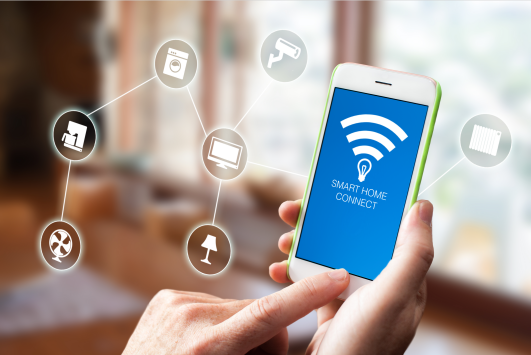Wi-Fi 6 and 5G provide today's best wireless IoT connectivity

Wi-Fi 6 and 5G provide today's best wireless IoT connectivity

IoT innovation has seen the growing adoption of Wi-Fi to power everything from factory robots to vending machines.
The higher throughput offered by Wi-Fi 6 shows how the technology can fit into a range of use cases. In some cases, this makes Wi-Fi a more attractive connectivity option than cellular because it brings the same wireless benefits but costs less.
The main advantage of Wi-Fi 7 is that it provides extremely high throughput using the 2.4GHz, 5GHz and 6GHz frequency bands. The move to Wi-Fi 7 will bring a massive increase in overall capacity while reducing latency and increasing speed.
Wi-Fi 7 represents a major change from Wi-Fi 6, which itself offered fast connections. The spec suggests that Wi-Fi 7 will deliver speeds of up to 46Gbps to a single client, dwarfing the already fast 9.6Gbps of Wi-Fi 6. However, the Wi-Fi 7 specification won't be finalized until 2024, and the technology is still in development.
Today, that leaves us with Wi-Fi 6—not a bad thing, as the technology offers a great option for connecting devices with relatively low latency, speed, high device density, and a future upgrade path. In many ways, Wi-Fi 6 laid the groundwork for Wi-Fi 7, as it made the market realize that Wi-Fi is an excellent choice for many deployment scenarios.
Wi-Fi 6 is sufficient to support innovative use cases such as automated guided vehicles, industrial robotics, and many other applications. In indoor venues such as stadiums, large venues, offices, hotels, etc., Wi-Fi 6 has attractive properties. In addition, the technology is being used in the automotive industry to support manufacturers' applications such as infotainment, monitoring, maintenance and upgrades, while increasing the personalization of vehicle features.
These advantages have allowed the adoption of Wi-Fi 6 to start dominating deployments. IDC estimates that within the next two years, Wi-Fi 6 will account for 79% of all Wi-Fi product shipments. The company expects Wi-Fi 6 device shipments to reach 2 billion in 2021, accounting for more than 50% of all Wi-Fi shipments. The company expects Wi-Fi 6 product shipments to exceed 3.5 billion in 2022; nearly 20 percent of Wi-Fi 6 devices this year are capable of supporting 6 GHz.
The momentum behind Wi-Fi 6 is swinging by comparing Deloitte's 2021 study on advanced wireless adoption with the company's 2020 study. The 2020 study found that U.S. network executives still see 4G/Long Term Evolution (LTE) and current or previous versions of Wi-Fi as the most critical wireless technologies for their business; most believe 5G and Wi-Fi 6 will Coming in the next few years. Attitudes are changing rapidly, with network decision makers around the world now seeing 5G and Wi-Fi 6 as the most important wireless technologies in their business plans.
Deloitte found that Wi-Fi 6 adoption is well beyond the planning stage, with two-thirds of respondents organizations already piloting or deploying Wi-Fi 6 solutions, while 58% are in the process of implementing 5G. Same deployment. Enterprise applications are expected to become a significant part of the Wi-Fi 6 market, with analyst firm ABI Research expecting Wi-Fi 6 enterprise access point shipments to increase from 4.3 million in 2021 to 13.4 million in 2026, at a CAGR of 25%.
Industry 4.0, smart manufacturing, connected car and infotainment industries are all looking to take advantage of Wi-Fi 6 and 5G. Therefore, it is important to evaluate both technologies side-by-side and recognize that each has compelling characteristics that can bring to the enterprise. This means that both technologies will coexist; each plays an important role in the future of wireless. And, unlike past generations of wireless technology, it's not an either-or decision.
5G cellular and Wi-Fi 6 — and later Wi-Fi 7 and 6G — networks will be able to interoperate and be seen as complementary technologies in the wireless ecosystem. Deloitte's research found that organizations say they prefer Wi-Fi 6 for indoor, campus and fixed network scenarios, while they will turn to 5G for outdoor, off-campus and mobile networks.
Parallel adoption of these technologies makes sense, with 45% of survey respondents already deploying Wi-Fi 6 and 5G in their business or conducting pilots/trials, with another 35% actively preparing to use both. two techniques. Nearly all expect their organizations to use both 5G and Wi-Fi 6 within the next two to three years. Projected investments reflect shared adoption, with Deloitte reporting that from 2021 to 2024, these organizations are expected to split wireless spending between Wi-Fi (48%) and cellular technology (52%).
In the automotive market, Quectel sees a lot of adoption for Wi-Fi 6, with access points designed to support gigabit in-car hotspots and provide efficient Wi-Fi connectivity throughout the vehicle; support for ultra-high-performance on multiple monitors High-definition (ultra-HD) video streaming, screen mirroring for compatible devices, and wireless backup cameras.
Wi-Fi 6 also features full MIMO client capabilities and is designed to extend range at high data rates to connect to external access points for car services such as vehicle diagnostics, software updates and automatic check-in upon arrival at the dealership. Additionally, the technology will provide improved connectivity and an enhanced in-car experience. As vehicle connectivity continues to evolve from 4G to 5G, Wi-Fi 6 is an integral part of connectivity evolution as it enables seamless connectivity between multiple devices in crowded environments.
Even though Wi-Fi 7 is already leading the way in development, Wi-Fi 6 is a new generation of Wi-Fi and therefore will exist for a long time in sync with the development of the IoT industry. As IoT device deployments reach massive scale, more and more devices require high throughput, such as virtual reality devices. Other applications require low latency, such as industrial control, or require low power consumption, such as those using battery power. Wi-Fi 6 is well positioned to meet these needs and cope with the dramatically increased device densities demanded by the age of billions of devices.
By using OFDMA, MU-MIMO, TWT, BSS shading and spatial reuse techniques, Wi-Fi 6 products achieve significantly improved performance, addressing density and interference issues. When aligned with 5G, IoT organizations can adopt Wi-Fi 6 and access the most appropriate connectivity for their deployment, trusting that each technology can coexist and will support devices for the long term.
We are in the era of 5G and Wi-Fi 6 today, but this sets the scene and provides the sound foundation and upgrade path for 6G and Wi-Fi 7 in the future.